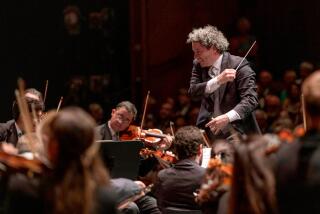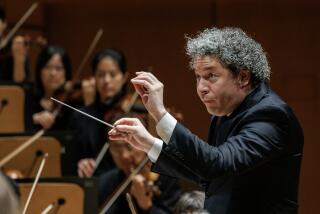Dean Drummond dies at 64; microtonal composer and musician
- Share via
Drawn to imaginative ideas about sound and pitch, musician and composer Dean Drummond found the traditional instruments of European classical music inadequate to perform the seemingly “out of tune” intervals of microtonal music.
So he followed the lead of his mentor — iconoclastic American composer Harry Partch — and invented instruments that would produce a complete palette of tonal pitches. The music makers were known by such fittingly unconventional names as the zoomoozophone and juststrokerods.
“Music using only 12 tones,” he told the Pittsburgh Post-Gazette in 2011, “is like buying a box that has 12 crayons, when you could have more fun with the one that contains 72.”
FOR THE RECORD:
Dean Drummond: The obituary of microtonal composer Dean Drummond in the April 22 LATExtra section misspelled the last name of his companion, Esther Starry Schor, as Shor. —
It was his colorful way of explaining that traditional classical music and jazz divide the octave into 12 pitches, whereas he preferred to compose using Partch’s fundamental technique of dividing the octave into more than 30 microtonal pitches.
He also co-founded a cutting-edge ensemble, Newband, devoted to playing microtonal music.
Drummond, 64, died April 13 in Princeton, N.J., according to his companion, Esther Starry Shor. He had multiple myeloma.
Composers including John Cage, Muhal Richard Abrams and Bob Telson have composed works for the zoomoozophone, described on Drummond’s website as “a 31-tones-per-octave, just-intoned metalophone, played on usually with mallets, but also with bass bow, consisting of 129 suspended aluminum tubes.”
Juststrokerods is a smaller but equally fascinating, personally expressive instrument that Drummond described as “13 solid aluminum rods, justly tuned from pitches derived from a 31-tone source scale and covering one octave. The player’s fingers work like a bow, producing a clear crystalline ringing tone.”
Despite the seemingly bizarre qualities of the instruments and the ear-challenging qualities of their unfamiliar pitch production, Drummond’s compositions were often praised for their atmospheric qualiti4es.
In a 1998 Washington Post review of Drummond’s new music for a screening of the 1924 silent film “Der Letzte Mann” (“The Last Laugh”), Joseph McLellan wrote: “It is music that is not only atonal but microtonal; music that finds expressive power in the spaces between, for example, B and B-flat. And to play it, [Drummond] uses not only the old, familiar flute, trumpet, cello and synthesizer, but also instruments that have — and live up to — such names as boo, chromelodeon, spoils of war and kithara.”
Dean Drummond was born Jan. 22, 1949, in Los Angeles, one of four children of Gilbert and Elaine Drummond. He received a bachelor’s degree in 1971 from USC and a master of fine arts from CalArts in 1973.
He was exposed to microtonal sounds while studying with and serving as an assistant to the unorthodox Partch. Drummond was also influenced by another teacher-mentor, Don Ellis, a composer and trumpeter who applied closely pitched interval techniques to jazz improvisations and compositions. Drummond also studied with composer Leonard Stein, a former associate of Arnold Schoenberg.
Drummond performed in the premieres of Partch’s “Delusion of the Fury” and “Daphne of the Dunes,” both written in the 1960s. Drummond also was a member of Partch’s ensemble on Columbia recordings that were made in the late ‘60s.
After moving to New York City in 1976, Drummond and his then-wife, flutist Stefani Starin, formed Newband. The ensemble’s repertoire reached from traditionally tonal classical music and jazz to the music of Partch and newly written compositions and improvisations based on microtonal principles. Most of Drummond’s music was composed for Newband’s highly varied repertoire. The ensemble’s recordings also included works by Cage, John Zorn, Thelonious Monk, Anne LeBaron and others.
In 1990 Drummond became the curator of the collection of microtonal instruments created and constructed by Partch, who died in 1974 in San Diego. They are part of the Harry Partch Institute at New Jersey’s Montclair State University.
Eager to keep the legacy alive, Drummond performed many of Partch’s best-known works, as well as new compositions of his own, on such original Partch instruments as cloud chamber bowls, harmonic canons, kithara and chromelodeon. Drummond and other members of Newband also created their own microtonal instruments, including the zoomoozophone and juststrokerods, as well as the tenor violin and quarter-tone flute.
Drummond’s two children with Stefani Starin chose to use the surname Stardrum to honor both of their parents’ last names.
Drummond is survived by Ruby Stardrum and Booker Stardrum; his companion, Esther Starry Shor; brother Barry Drummond; and sisters Aleta Drummond and Ilana Drummond.
More to Read
Start your day right
Sign up for Essential California for the L.A. Times biggest news, features and recommendations in your inbox six days a week.
You may occasionally receive promotional content from the Los Angeles Times.






